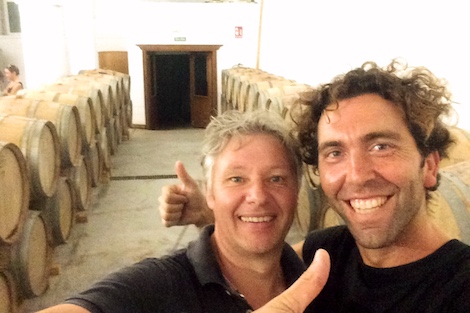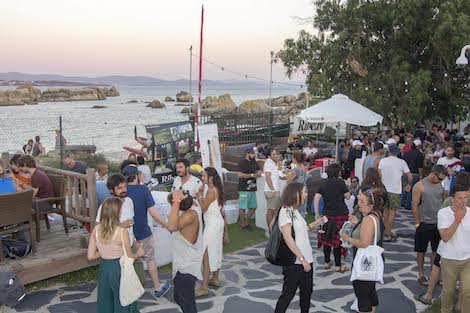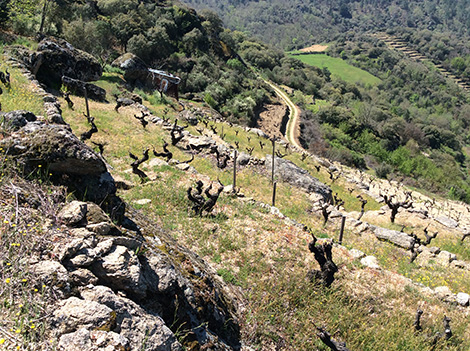
When Alejandro Muchada was a model student of Architecture in the University of Seville, the name David Léclapart meant nothing to him. In fact, like many of his generation, Alejandro wasn’t interested in wine —to the point that he had never tried it.
Everything changed in 2011. As his annual research trip to Morocco to prepare his doctor’s degree coincided with Ramadan, Alejandro changed plans and grabbed his rucksack to work in organic farms in France. While there, a friend asked him if he wanted to do the harvest in Champagne with the relatives of another friend, called Clotilde Léclapart. He jumped at the chance and travelled to Trépail, the village on the Montagne de Reims where renowned biodynamic producer David Léclapart works his family’s three hectares of vines since 1998.
“I didn’t know anything about wine and had never heard of David but the atmosphere I saw in his house during the seven-day harvest was fantastic. It was like an initiation journey, because I had never heard about biodynamics before. I was floating on air when I returned home”, remembers Alejandro with a broad grin. “I was really taken by David’s personality. He is like a 50-year-old kid who loves what he does and is super generous. That’s why I returned to Trépail the following year.” In 2013, during a family holiday in Sanlúcar, it was the turn of Léclapart to fall head over hills with the light and the albariza soils of Sanlúcar, so similar to the craie in Champagne. He now even talks of retiring down there.
A small-scale endeavour
Not long after the visit of his vigneron friend, Alejandro —alongside Miguel Gómez, Fernando Angulo and Carmen Caballero set up Alba Viticultores. They produced a set of highly original natural whites and pét-nats with old Listán Blanco (Palomino) grapes, but after three years the group decided to split. Alba is now managed by Fernando and Carmen, whereas Miguel works with his brother in Mahara Viticultores.
Cádiz-born Alejandro was the only one without a background in wine, but he enjoyed working the vineyard so he decided to join the crews of labourers who work the land in Sanlúcar to learn to prune, desucker and other farming tasks. “I owe a lot to Juan Morales, mi mentor in the vineyard; few people are as capable as him when it comes to explaining how to prune,” he says candidly. “These days there are very few crews with young people; it is low-paid, precarious labour.”
With the support, experience and example of his friend Léclapart —a vigneron making biodynamic wines with little intervention— and convinced that these practices are viable in Sanlúcar, Alejandro decided to become a full-time grape grower and continue working the two small plots he had rented.
These days, Muchada-Léclapart includes a small rented winery in Sanlúcar’s Barrio Alto, three hectares of biodynamic vineyards and half a dozen wines (including an anecdotal pet-nat) made with no flor or addition of alcohol that try to capture the authentic expression of Palomino and the albariza soils where it grows. This is their business model: artisan and under their control, from from the vine to the bottle.
Despite the expectation created by the fact that a renowned Champagne producer is investing in the Sherry Triangle, they have successfully managed to work quietly avoiding any hype on the media. Léclapart travels to Sanlúcar during the harvest and bottling and at several other moments during the year, while Alejandro manages the day to day of the project.
“I like this work because it’s varied: the vineyards, the winery, dealing with sales, welcoming visitors… I never get bored. Working in the vineyard is harder than I expected, particularly the way we do it, but we are gradually improving conditions,” says Alejandro. “Last year I sprayed on my own, with the rucksack, the three hectares we have. It’s tough with this heat but we have an atomizer so it will be quicker and more comfortable. He ploughs the vineyards with his friend Quino’s mule, but he is looking to buy a small tractor to replace the animal in certain tasks. It’s the search for natural methods without giving up a practical approach.
Moscatel and Palomino
They own a plot —La Platera— and rent two more. Another plot they worked in Pastrana Baja —whose grapes are in some of the 2016 wines— has been discarded given its low production and distance from the other plots.
In Miraflores Alta they rent a plot with old palomino vines. The other one, 0.7 hectares with 40-year-old Moscatel planted on sandy soils, survives in Pago Abulagar in Chipiona, a coastal village next to Sanlúcar with very few vineyards. It was in a bad shape when they hired it, but they are gradually recovering it. “The owner laughs at the things we do like using sexual confusion to avoid diseases, tilling the land between the vines and planting green crops with clover to enhance nitrogen and create biodiversity”, explains Alejandro. “The vineyard is under transformation, looking to achieve a new balance. Farmers here use cultivators and kill the soil; we practice a different kind of viticulture.”
They purchased La Platera, 1.7 hectares also in Pago Miraflores, in 2017. To encourage biodiversity in this long and narrow plot, Muchada and Léclapart have planted fruit and almond trees to add to the beautiful apricot tree that stands tall in the centre of the property. The highest part of the vineyard is crowned by sculptural 60-year-old vines planted on pure albariza whereas the lowest part, with pockets of clay in the chalk, has young vines (20 years old) mostly Palomino California, the productive clone that is dominant in the Sherry Triangle. Facing the cool westerly winds from the ocean, La Platera is more sensitive to mildew but it also produces wines with less alcohol.
Muchada explains how challenging it is to reconstruct a vineyard like this. “With such an amazing amount of genetic information, this heritage should be protected. Massal selection was done by expert growers using the best plant material in the vineyard; their perfect shapes and high yields are due to the fact that these plants were not forced to be trellised. The old folk die and no matter how much I learn, I will never attain their knowledge”, he laments.
The old folk also taught him vara y pulgar, the traditional pruning method in the Sherry Triangle that encourages yields, longevity and higher protection against wood-eating insects. This style of short pruning, unknown in Champagne, caught the attention of Léclapart. “He didn’t understand why we work with old wood. We pruned two lines of vines in his way but the old folk said to me: 'Ale, vines are going to age very quickly because it’s a long pruning'. They were of course right. As David says, there’s too much strength here, and I think vara y pulgar pruning is designed to control that strength.”
Artisan model
All of his wines are vinified by plots and grape varieties, even separating the old and the new palomino. Winemaking is simple: after the early-morning manual harvest in (larger) Champagne boxes, grapes are sent to a horizontal press. To avoid stainless steel, which they say ionizes wines and makes them restless, they brought enameled steel tanks from France. The wines are not cooled, instead two air conditioning units are placed in the winery to cool off the atmosphere. During pressing, 3g/hl of SO2 are added and wines are neither filtered nor clarified. Despite this simplicity, Muchada and Léclapart refuse to call their wines natural. “We don’t like faulty, unclean wines or with high volatile acidity. It’s the same with David’s champagnes; he doesn’t refer to them as natural even though they have no sulfur or dosage added”.
They made 4,000 bottles on the 2016 vintage —all of them in sherry casks— but they chose to launch the project once the 2017 wines (16,000 bottles) were ready. They wanted people to have a clear, real idea of the style of the Muchada-Léclapart wines, made outside the boundaries of the DO.
“I continued the Alba line and in 2016 I made two pét-nats with each of the plots we worked, but we are not making more sparkling for sale,” says Alejandro, who hasn’t developed a palate for fortified wines. “Coming from Champagne, David wanted to try his hand with whites; he thinks whites express our terroir better than pét-nats. Ours, called Fugaz (€32.60), is only sold in Spain.”
Going against the tradition of making sweet wines in Chipiona, last year the pair decided to make a dry white with Moscatel. As they only picked 1,600kg, not enough for their 4,000kg press, they blended it with Palomino (45%) to make Elixir (4,000 bottles, €45.70), an exotic different wine with the aromatic exuberance of Moscatel but toned down and refined with the Palomino, which adds salinity and persistence on the palate.
Beyond Elixir, the three main cuvées are Univers (4,000 bottles, €28.95) sourced from young La Platera vines and vinified in steel, Lumière (6,500 bottles, €57.95) old Palomino from the higher parts of La Platera and aged in used 225-litre barrels for nine months and Étoile (2,500 bottles, €45.70), an old vine Palomino aged in manzanilla casks from Ignacio Partida, the foreman at legendary vineyard El Armijo. The very original Vibrations (300 bottles in 2017, 700 in 2016, €45.70) undergoes skin contact and gains complexity and depth with some time in bottle (the 2016 is now at its peak). All of them are saline, long, elegant and with distinctive personality —miles away from the idea that most people, specially abroad, have of wines made in this part of the world.
Learning along the way
The wines have been warmly welcomed and thanks to the importer network of Léclapart, they will be present in leading countries, explains Alejandro. He doesn’t throw caution to the wind, though. “It helps to have the experience and prestige of David, but that’s also a handicap; he has been working for 20 years and is widely respected so expectations are very high. The first vintage might be an easy sell, but the second will be key.”
Their plans for the future include transforming the vineyards and learning along the way. Luckily for them, neither David nor Alejandro have the weight of history behind them, as it might be the case of Ramiro Ibáñez or Willy Pérez. They have studied the history of Jerez and care deeply about uncovering the region’s worth and potential. For us, the essence lies not on the history but on the soil and the vines; we might also be able to reach a historical expression but we don’t start in the history.”, explains Alejandro, whose ancestors moved from Jurançon to Cádiz in the 18th century. Interestingly enough, his contemporary relatives also make wine in this French region.
At the age of 35, Alejandro doesn’t miss his former profession although he still belongs to a group that does research about African issues. “One works in cooperation wanting to change the world but I learnt in Morocco that the best way of helping is from here, living differently.”
Once he accepted that, he became interested in organic agriculture and life in the countryside as a way of self-fulfillment. “Grape growers and the old country folk are kind, humble and full of joy, despite the tough lives they’ve had. Their wisdom can only be reached experiencing life along the way; it’s not something you learn,” believes Alejandro. He is well on that path.

Yolanda Ortiz de Arri
A journalist with over 25 years' experience in national and international media. WSET3, wine educator and translator
NEWSLETTER
Join our community of Spanish wine lovers






